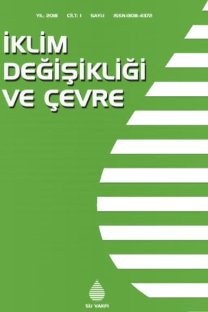Arıtma Tesislerinde Yaşam Döngüsü Değerlendirmesi: Bursa Organize Sanayi Bölgesi Su Üretim Tesisi Örneği
Bu çalışmada Bursa Organize Sanayi Bölgesi’nde (BOSB) yer alan işletmelerin proses suyu ihtiyacını karşılayan su üretim tesisinin çevresel yükünün belirlenebilmesi için yaşam döngüsü değerlendirmesi yöntemi uygulanmıştır. Su üretim tesisinde, Nilüfer deresi suları konvansiyonel ve ileri arıtma sistemleri ile proses suyu haline dönüştürülmektedir. Sistem sınırları beşikten kapıya olarak belirlenen yaşam döngüsü değerlendirmesinde, envanter analizinde tesis iç raporlarındaki veriler, SimaPro 8 yazılımı ve ReCiPe etki analizi metodu kullanılmıştır. Fonksiyonel birim olarak 1m3 proses suyu seçilmiştir. Tesisi oluşturan tüm alt sistemlerin iklim değişikliği, stratosferik ozon tabakasındaki incelme, ötrofikasyon, asidifikasyon, toksik emisyonlar gibi çevresel unsurlar üzerindeki etkileri belirlenmiştir. Çalışma sonucunda su üretim tesisinin ileri arıtma sisteminde yer alan ters ozmos ünitelerinin, tesisteki üniteler içerisinde en yüksek çevresel yüke sahip olan üniteler oldukları belirlenmiştir. Bunun temel nedeni, bu üniteler işletilirken ortaya çıkan yüksek orandaki elektrik tüketimidir. Çevresel yük oluşturan unsurlar sıralamasında ikinci sırayı ise tesiste kullanılan kimyasal maddeler almaktadır.
Anahtar Kelimeler:
İklim değişikliği, İleri arıtma, Proses suyu, SimaPro 8
___
- Çakır, Z., (2016), Bursa Organize Sanayi Bölgesi Su Üretim Tesisi’nin Çevresel Performansının Yaşam Döngüsü Değerlendirmesi Yöntemiyle İyileştirilmesi, Yüksek Lisans Tezi, Uludağ Üniversitesi Fen Bilimleri Enstitüsü Çevre Teknolojisi Anabilim Dalı, 2016, Bursa.
- Garfí, M., Cadena E., Sanchez-Ramos D., and Ferrer I., (2016), Life cycle assessment of drinking water: Comparing conventional water treatment, reverse osmosis and mineral water in glass and plastic bottles, Journal of Cleaner Production, 137:997-1003.
- Ioannou-Ttofa, L., Foteinis, S., Chatzisymeon, E., and Fatta-Kassinos, D. (2016), The environmental footprint of a membrane bioreactor treatment process through life cycle analysis, Science of the Total Environment, 568:306-318.
- Le T., Xin L., XueWei L., ZengWei Y., and Qiong Z. (2013), Life cycle assessment of water reuse systems in an industrial park, Journal of Environmental Management, 129:471-478.
- Pintilie, L., Torres, C.M., Teodosiu, C., and Castells, F., (2016), Urban wastewater reclamation for industrial reuse: An LCA case study, Journal of Cleaner Production, 139, 1-14.
- Ribera, G., Clarens, F., Martinez-Llado, X., Jubany, I., Marti, V., and Rovira, M., (2014), Life cycle and human health risk assessments as tools for decision making in the design and implementation of nanofiltration in drinking water treatment plants, Scıence of The Total Envıronment, 466:377-386.
- Rodriguez, R., Espada, J.J., Pariente, M.I., Melero, J.A., Martinez, F., and Molina, R., (2016), Comparative life cycle assessment (LCA) study of heterogeneous and homogenous Fenton processes for the treatment of pharmaceutical wastewater, Journal of Cleaner Production, 124, 21-29.
- Rodriguez, O., Villamizar-Gallardo, R., García R., and (2016), Life cycle assessment of four potable water treatment plants in northeastern Colombia, Ambiente & Água - An Interdisciplinary Journal of Applied Science, 11(2):268-278.
- Sharaai, A.H., Mahmood N.Z., and Sulaiman, A.H. (2010), Life cycle ımpact assessment (lcıa) in potable water production in malaysia: potential ımpact analysis contributed from production and contruction phase using eco-indicator 99 evaluation method, World Applied Sciences Journal, 11 (10): 1230-1237.
- Ortiz, M., Raluy, R.G., and Serra, L. (2007), Life cycle assessment of water treatment technologies: wastewater and water-reuse in a small town, Desalination, 204(1):121-131.
- Tarnacki, K., Melin, T., Jansen, A. E., Medevoort, and J. Van. (2011), Comparison of environmental impact and energy efficiency of desalination processes by LCA, Water Science and Technology: Water Supply, 11 (2):246-251.
- Theregowda, R., Vidic, R., Dzombak, D.A., and Landis, A.E. (2014), Life cycle impact analysis of tertiary treatment alternatives to treat secondary municipal wastewater for reuse in cooling systems, Environmental Progress & Sustainable Energy, 34(1):178-187.
- Vince, F., Aoustin, E., Bréant, P., and Marechal, F. (2008), LCA tool for the environmental evaluation of potable water production, Desalination, 220:37-56.
- Zang, Y.W., Li, Y., Wang, C., Zhang, W.L., and Xiong, W., (2015), Towards more accurate life cycle assessment of biological wastewater treatment plants: a review, Journal of Cleaner Production, 107, 676-692.
- ISSN: 1308-4372
- Başlangıç: 2008
- Yayıncı: Su Vakfı
Sayıdaki Diğer Makaleler
Akuaponik (Biyolojik Arıtma Tekniği) Tekniği ile Balık Atıksularının Arıtılması
Güray SALİHOĞLU, Zeynep ÇAKIR, Nezih Kamil SALİHOĞLU
Seyhan Havzası Yağış Verilerinin Eğilim Analizi
Şimal Yüce, Burcu Ercan, Musa EŞİT, Mehmet ÜNSAL, Mehmet İshak YÜCE
Nilüfer Çayı Sedimentinde Polisiklik Aromatik Hidrokarbon (PAH) Seviyelerinin İncelenmesi
PAH'lar Ve PCB'lerin Atmosferik Konsantrasyonları: Bursa Doğu Atıksu Arıtma Tesisi Örneği
Berfu BÜKLER, Yücel TAŞDEMİR, Fatma ESEN
Evsel Atıksuların Solar TiO2 Fotokatalizi ile Dezenfeksiyonu
